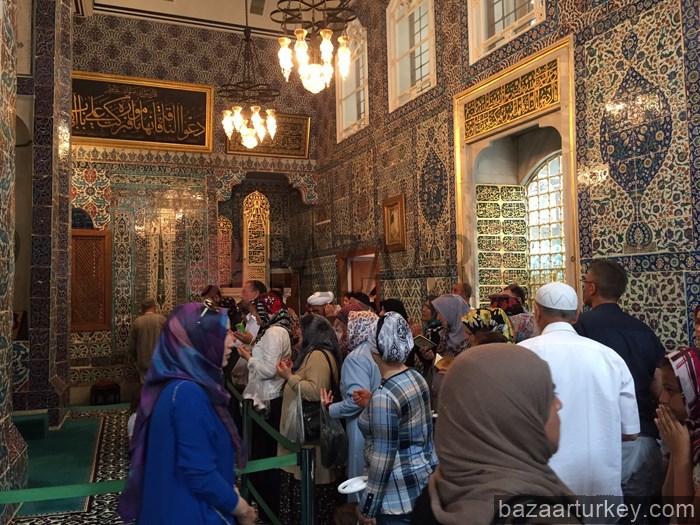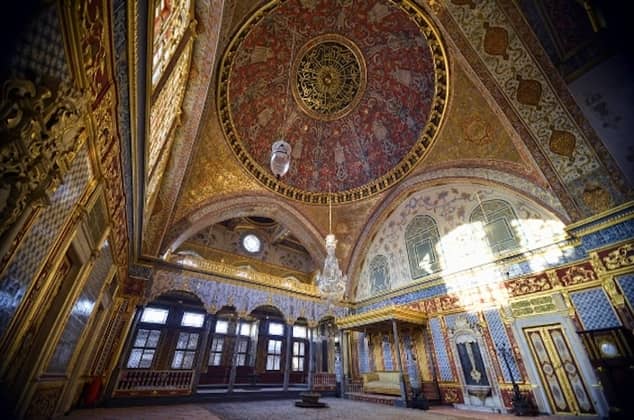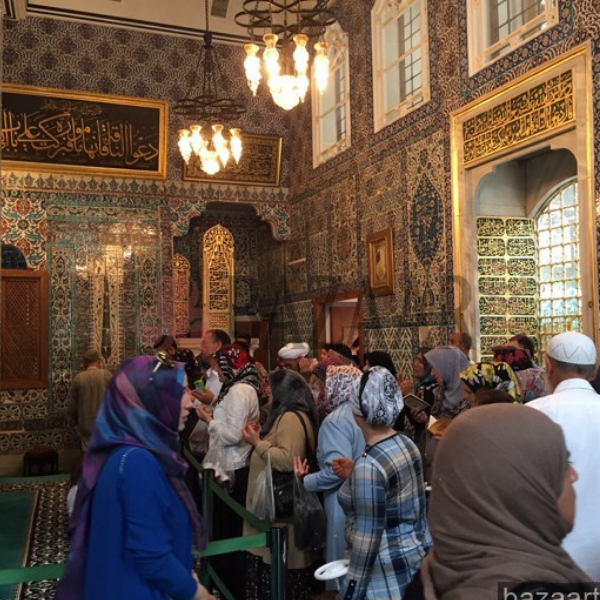Description

Visiting Sahaba Tombs and Sacred Belongings of Prophet Hz.Muhammad ( S.A.V ) Istanbul
The Prophet Muhammad ( SAW ) said: “Verily you shall conquer Constantinople. What a wonderful leader its leader shall be, and what a wonderful army that army will be!” (Musnad Ahmad).
TOUR PROGRAMME : This is a religious ziyarat and tours for muslim families and individuals that are visiting istanbul for vacation or before or after their Umrah or Hac trips.
Half Day Sahaba Tour and Half Day Topkapi Palace Visit
including Topkapi Palace Ticket and lunch
* Pickup from the hotel at 10:00 Am
* Visiting Yeralti Camii ( Underground Mosque ) ,
* Visiting Tomb of Hz. Vehb Bin Huseyre
* Visiting Tomb of Amr Bin As
* Visiting Tomb of Sufyan Bin Uyeyne
* Edirnekapi & City Walls Area Visit
* Visiting Tomb of Hz. Abdullah El-Hudri
* Visiting Tomb of Hz. Hafir
* Visiting Tomb of Hz. Abdulsiddik Bin Amir
* Visiting Tomb of Hz. Ebu Seybetul Huri
* Visiting Tomb of Hz. Muhammed-Ul Ensari
* Visiting Tomb of Hz. Ahmad El Ensari
* Visiting Tomb of Hz. Kaap ( RA )
* Visiting Tomb of Cabir ( RA )
* Visiting Tomb of Hz. Hamidullah El Ensari
* Visiting Tomb of Hz. Muhammed El Ensari
* Visiting Tomb of Edhem ( RA )
* Visiting Tomb of Ebu Derdag Sahabei Ikr.
* Eyup Mosque & Cemetery Visit
* Visiting Tomb of Eyup El Ensari ( RA )
* Lunch in a local Turkish restaurant
* Return to SULTANAHMET Area around between 14:30 Pm – 15 : 00 Pm
* After tour finishs we will go to Sultanahmet and give tour ticket for Topkapi Palace Museum. You will visit inside and please dont forget to visit Islamic Section of the palace where you will see all precious things including Muhammad’s ( S.A.V ) cloak and sword.
* Return back to hotel – 17:00
Tour Includes ;
Hotel Pick up & Drop off,
Private minivan & Driver,
English speaking tour guide,
Lunch in a Local Restaurant,
Parking fees,.
Museum Entrance fees,
Complimentary drinks,
All Taxes
Bazaar Turkey – Les Arts Turcs Art Studio
Alemdar Mh. Incili Cavus St.
No: 19 Floor : 3 (Behind The Underground Cistern)
Sultanahmet 34110
Istanbul, Turkey
Contact : Mr. Alp or Mr. Nurdogan ( Phone : +90 544 220 10 22 )
E-mail : info@bazaarturkey.com
Google Maps : https://goo.gl/maps/uXuyRmELZsx
Recommended in Trip Advisor
Photos from our Sahabe Tomb visits / ziyarats in Istanbul


The first mosque on the European side of Istanbul was built inside the Rumeli Castle in 1452. The first grand mosque which was built in the city proper is the EyUp Sultan Mosque (1458), while the first imperial mosque inside the city walls was the Fatih Mosque (1470) which was built on the site of the Church of the Holy Apostles, an important Byzantine church which was originally edificed in the time of Constantine the Great.
Many other imperial mosques were built in the following centuries, such as the famous Suleymaniye Mosque (1557) which was ordered by Suleiman the Magnificent and designed by the great Ottoman architect Sinan, and the famous Sultan Ahmet Mosque (1616) which is also known as the Blue Mosque for the blue tiles which adorn its interior.
Istanbul was the final seat of the Islamic Caliphate, between 1517 and 1924. The personal belongings of Mohammed and the earliest Caliphs who followed him are today preserved in the Topkapı Palace, the EyUp Sultan Mosque and in several other prominent mosques of Istanbul.
Note : In the tours, ziyarats we explain you the stories of the places and the importance of the tombs, sahabas & Evliyas buried in Istanbul.
* About Eyup El Ensari : He is the companion and standard bearer of the prophet Mohammed. The tomb is located in the Eyup district in Istanbul beyond the old city walls of Constantinople on the south part of the Golden Horn.
* Eyup Sultan Mosque : It was built by the grave of the armor-bearer prophet Muhammad who died during Constantinople attack.
* Topkapi Palace : After the conquest of Istanbul by Mehmed the Conqueror at 1453, construction of the Topkapı Palace was started at the year 1460 and completed at 1478 . Palace was built upon a 700.000 squaremeters area on an Eastern Roman Acropolis located at the Istanbul Peninsula between Sea of Marmara, Bosphorus and the Golden Horn. Topkapı Palace, was the administrative, educational and art center of the Empire for nearly four hundred years since Mehmed the Conqueror until Sultan Abdulmecid who is the thirty-first Sultan. Although Palace was abandoned by the Ottoman Dynasty by moving to the Dolmabahçe Palace at middle 19th century, Topkapı Palace was protected its importance everytime.

Pavilion of the Holy Mantle and Holy Relics
The Privy Room (Has Oda) was constructed in the Inner Courtyard in the time of Sultan Mehmed II (r. 1451–81) to serve as the private apartments of the sultan, for which purpose it was used until the middle of the 16th century. Prior to their accession to the throne, the sultans would come to this room to pray and receive homage from the Privy Room officials before leaving for the ceremony.

The Chamber of the Holy Relics, located within the Privy Room, contains religious objects sent to the Ottoman sultans at various times between Sultan Selim the Grim’s assumption of the caliphate in the 16th century to the end of the 19th century. The caliphate passed from the Abbasids to the Ottomans with Selim’s conquest of Mamluk Egypt in 1517, upon which event the Holy Mantle of the Prophet (Hırka-i Sa`âdet) was given to Selim by al-Mutawakkil III, the last Abbasid caliph. The dispatching of holy relics to Istanbul would continue thereafter, particularly during the period of increasing Wahhabi assaults on holy places and objects in the late 18th and the 19th century, when such objects were gradually removed to the Chamber of the Holy Relics for greater protection. Similarly, the holy objects found in Medina were sent toTopkapı Palace for the same reason during the First World War.

Among the most important holy relics to be collected in this way between the 16th century and the first half of the 20th century were the Holy Mantle of the Prophet; the hair from the Prophet’s beard; the reliquary in which was kept the Prophet’s tooth, broken during the Battle of Uhud on 19 March 625; and the footprints, letters, bow, and sword of the Prophet. There are also holy relics attributed to other prophets and to the companions of the Prophet Muhammad: the tray used by Abraham; the staff of Moses; the sword of David; the robe of Joseph; the swords of the Prophet Muhammad’s companions; and the shirt, mantle, praying mat, and chest of Muhammad’s daughter Fatimah.
History of Topkapi Palace
After the conquest of Istanbul by Mehmed the Conqueror at 1453, construction of the Topkapı Palace was started at the year 1460 and completed at 1478 . Palace was built upon a 700.000 squaremeters area on an Eastern Roman Acropolis located at the Istanbul Peninsula between Sea of Marmara, Bosphorus and the Golden Horn. Topkapı Palace, was the administrative, educational and art center of the Empire for nearly four hundred years since Mehmed the Conqueror until Sultan Abdulmecid who is the thirty-first Sultan. Although Palace was abandoned by the Ottoman Dynasty by moving to the Dolmabahçe Palace at middle 19th century, Topkapı Palace was protected its importance everytime.
After the establishment of the Republic of Turkey, Topkapı Palace, was transformed into a museum at the date April 3th 1924 and it was also the first museum of the Republic of Turkey. Topkapı Palace Museum is covering approximately 400.000 squaremeters at the present day. Topkapı Palace divided from the city from the land-side by the Imperial Walls which is made by Mehmed the Conqueror. It divided from the city also from the sea-side by the Byzantine Walls. Topkapı Palace is one of the biggest palace-museums with its architectural structures, collections and approximately 300.000 archive papers.
There are surroundings like gardens and squares around the Palace. Palace which its Main Gate located at the Hagia-Sophia side, has four courtyards which has passages between them. At the first courtyard, Hagia-Irene Church which was used as Armory and the outer service buildings like Mint, Oven and Hospital were located there.

Second Courtyard was the Divan Square (Square of Justice) that hosting the administrative buildings fort the Empire. This courtyard was also a ceremonial courtyard. Divan-ı Hümayun (Kubbealtı / Imperial Council) and Treasury of the Divan-ı Hümayun were located on that courtyard. Behind the divan structure, there is the Tower of Justice which represents justice of the Sultan. Dormitory of the Halberdiers with Tresses and the Entrance of Harem were also located at this courtyard. There are also Privy Stable structures at the same side around an inner courtyard. At the Marmara side of the Courtyard of Justice, there are the Palace Kitchens and additional service buildings. Babüssaade (Gate of Felicity) where coronation, funeral and festival ceremonies held is located at the Northern side of the Courtyard of Justice.
The third Courtyard (Enderun – Inner Palace) was the section that the Palace aghas were educated and assigned to high ranks of the State. It formed by the dormitories and the structures belongs to the Sultan. Hall of Audience where Sultan accepts viziers and ambassadors, Enderun Library which was constructed by the Sultan Ahmed III, Treasury of Enderun also known as Conqueror’s Pavilion, Privy Room (Chamber of Sultan) and the Aghas’ Mosque which was constructed for the Enderun aghas at the reign of Fatih are the important structures of this courtyard. Courtyard is surrounded by the Big and Small Room Wards, Expeditionary Force Ward, Pantries’ Ward, Treasure Ward and the Privy Room Ward which added to the Privy Room at the 19th century.
From the Privy Room, and the Enderun Courtyard, there are passages to the Imperial Sofa courtyard which hosts to the kiosks and gardens. At the Marble Terrace part of this courtyard, there are Revan and Baghdat Kiosks, Circumsision Room and the Iftaree Canopy. Under this terrace, there is a hanging flower garden which surrounded by wooden Sofa Kiosk and the Tower of the Chief-Physician. At the Marmara side of this garden, there are Sofa Mosque, Mecidiye Kiosk and Wardrobe Room. It also known that there are lots of kiosks and service structures at the Privy Gardens which surrounds the Palace in axis of Maramara, Seraglio-Point and the Golden Horn.








Reviews
There are no reviews yet.